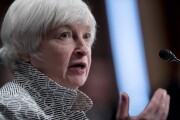A central bank digital currency could play a key role in protecting financial stability, Federal Reserve Board Vice Chair Lael Brainard said in a speech Friday morning.
In remarks delivered at a Bank of England conference in London, Brainard said a CBDC could be a settlement layer that connects a system of regulated stablecoins to one another and to public money.
“Given the foundational role of fiat currency, there may be an advantage for future financial stability to having a digital native form of safe central bank money — a central bank digital currency,” Brainard said in remarks delivered at the conference. “A digital native form of safe central bank money could enhance stability by providing the neutral trusted settlement layer in the future crypto financial system.”

Brainard warned that stablecoins, which she described as “the digital native asset that bridges from the crypto financial system to fiat,” are already becoming highly concentrated, with three coins accounting for 90% of transactions and two issuers holding an 80% market share. Should this trend continue, she argued, it risks the creation of a private, unregulated payment system.
The comments were the strongest endorsement a Fed official has given to the idea of a digital U.S. dollar to date. While the central bank has
During
Friday’s speech gave no such caveat. While falling short of an outright endorsement of a digital dollar, Brainard described the development of a CBDC as a “natural evolution” of the interoperability of public and private currencies.
She said it would ensure “strong public trust in the one-for-one redeemability of commercial bank money and stablecoins for safe central bank money.”
Brainard’s comments on CBDCs were part of a speech that touched on digital assets broadly and the need for enhanced regulation. In it, she said the Fed is closely watching the ongoing crypto sell-off, which has seen the price of Bitcoin declined 60% from April through June, while other assets have lost even more value.
The crypto market meltdown coupled with the demise of algorithmic stablecoins such as Terra stand as evidence, she said, that cryptocurrencies are not an inflation hedge, but rather a highly volatile, highly correlated asset class that is “vulnerable to deleveraging, fire sales, and contagion.”
Brainard noted that interconnectedness of he crypto market and traditional financial markets has been limited, indicating that it is not yet large enough or intertwined enough to pose a threat to broader financial stability. Still, she added, it is important for regulators to step in before it reaches that level.
“So this is the right time to ensure that like risks are subject to like regulatory outcomes and like disclosure so as to help investors distinguish between genuine, responsible innovation and the false allure of seemingly easy returns that obscures significant risk,” she said. “This is the right time to establish which crypto activities are permissible for regulated entities and under what constraints so that spillovers to the core financial system remain well contained.”
Brainard endorsed an approach that extends the current regulatory perimeter to include new entrants into the financial services space. She noted that many of the groups already fall under the purview of prudential regulation but regulators have not sufficiently kept pace with their technological advancements.
“The peer-to-peer nature of these activities, their automated nature, the immutability of code once deployed to the blockchain, the exercise of governance functions through tokens in decentralized autonomous organizations, the absence of validated identities, and the dispersion or obfuscation of control may make it challenging to hold intermediaries accountable,” she said. “It is not yet clear that digital native approaches, such as building in automated incentives for undertaking governance responsibilities, are adequate alternatives.”
The two areas in need of the greatest vigilance from bank regulators are stablecoins and bank involvement in crypto activity, such as providing custody accounts, issuing their own coins and facilitating crypto transactions, Brainard said.
While regulators are keen to address these issues, Brainard said they should not rush to bring the risks of crypto “into the heart of the financial system without the appropriate guardrails.” Instead, they must first determine what can be folded into the existing regulatory framework and what requires a newly tailored approach.
“It is important for banks to engage with beneficial innovation and upgrade capabilities in digital finance, but until there is a strong regulatory framework for crypto finance, bank involvement might further entrench a riskier and less compliant ecosystem,” she said.






